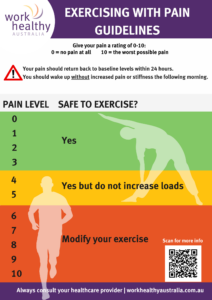
If your workers have recently experienced an injury or are managing long-term pain, they may wonder if it is safe to return to the gym and start exercising again. People often worry that getting back to exercising might worsen their pain and condition.
However, the good news is that exercising can be safe even if you are experiencing pain, and there may be some benefits to exercising with pain.
To make sense of this, there are a few key concepts that we need to explain.
- Pain experience does not necessarily reflect the level of tissue damage. Various factors can influence pain, and as pain persists, the relationship between pain and actual injury becomes less predictable and synonymous.
- Exercise reduces pain perception and has positive effects on mental health ¹. In healthy adults, exercise raises your pain threshold, and in patient populations, exercise has an analgesic effect for conditions such as low back pain, myofascial pain, osteoarthritis, chronic fatigue syndrome, and fibromyalgia.
- Experiencing pain during exercise can be beneficial. This was shown in a 2017 systematic review comparing programs using pain-inducing exercises versus non-painful ones. It demonstrated that individuals suffering from chronic pain who performed exercises with some level of pain reported significantly lower levels of pain in the short term than individuals who performed completely pain-free exercises.
Another more recent study in 2019 showed that following a standard rehab protocol within pain-threshold limits resulted in greater recovery of muscle strength and length compared to completely pain-free rehab.

What does this all mean?
It can be safe to exercise with pain. It is ok to want to avoid pain flare-ups while still exercising, for example, if you have lower back pain, you may look for exercises that don’t aggravate it, such as inclined push-ups, bench presses, leg presses, assisted chin-ups and so on, so that you can maintain your fitness and strength while staying in a comfortable range.
Exercising with pain (within your pain threshold) can benefit short-term pain and long-term function and healing.
How do you exercise with pain?
The below guide can be used for exercising with pain:
- Give your pain a rating of 0-10, with 0 being no pain at all and 10 being the worst possible pain.
- If you are in the 0-3 range, it is safe to train and increase loads.
- If you are in the 4-5 range, it is ok to train, but keep the load the same.
- If the pain is 6 and above, then it is best to modify what you are doing (speak to your healthcare provider or personal trainer).
It’s important to know that your pain/symptoms should settle quickly back to baseline levels after exercise (within 24 hours), and you should not feel increased pain or stiffness the following morning. If your pain does not return to baseline within that time frame, you may need to modify your training intensity or frequency.
Your body is resilient and adaptable, and loading your muscles and joints when rehabilitating is important in returning to full function and being pain-free. However, even though the above guide can be beneficial, it is important to get an accurate diagnosis from your onsite injury healthcare provider to ensure it is safe to exercise with your pain.
Exercise and pain – a resource for workers
Click below to download our Exercising With Pain poster.
Reference
Bement MKH & Sluka KA (2016). Exercise‐induced analgesia: an evidence‐based review In Mechanisms and Management of Pain for the Physical Therapist, 2nd edn, ed. Sluka KA, Ch. 10. pp. 177–201. Wolters Kuwer, IASP Press, Seattle
Sign up to our monthly enewsletter
"*" indicates required fields

